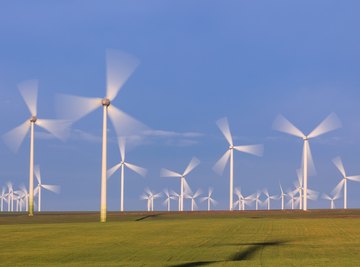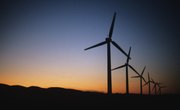
Since 2007, wind generating capacity in the United States has grown at a pace of 30 percent per year, faster than any other power generating technology. The growth rate continues to increase in spite of the complexity of utilizing wind technology. For example, there are still questions about the proper layout of wind farms and the amount of land area required to efficiently install them. Utility-scale wind power projects and residential wind turbines have a whole separate set of design considerations.
TL;DR (Too Long; Didn't Read)
Wind turbines need an unchanging and uninterrupted flow or air to work effectively, which means there must be no obstructions nearby. Researchers have suggested that for residential wind turbines 150 meters away from nearby obstructions is enough. In the case of wind farm spacing, turbines need to be at least 7 rotor diameters away from each other.
Residential Systems
A wind turbine is most effective when it operates in a steady, smooth, unchanging and uninterrupted flow of air. That never happens in the real world, but when planning where to install a wind turbine the locations has to be as close as possible to the ideal. For residential systems this isn't so much a question of how much area the wind turbine needs but of how much distance is required between the wind turbine and other obstructions. A rule of thumb is to install a wind turbine 150 meters (492.1 feet) away from any nearby obstruction, and at a height such that the bottom of the rotor blades will be 9 meters (29.5 feet) above the obstructions, including buildings and trees.
Wind Farm Turbine Spacing
Wind farms are arrays of large turbines designed to generate utility-scale electrical power. The large turbines in wind farms are no different than residential turbines in one respect: they work best with smooth flowing wind. If anything disturbs the air flow, it creates turbulence, making the turbine less efficient. Each wind turbine creates turbulence in the area behind and around it, so the turbines need to be spaced well apart from each other. The distances in this case are expressed in rotor diameters. The general rule-of-thumb for wind farm spacing is that turbines are about 7 rotor diameters away from each other. So an 80-meter (262-foot) rotor would need to be 560 meters -- more than a third of a mile -- from adjacent turbines. Researchers at Johns Hopkins University have proposed that twice as much spacing would increase overall efficiency.
Direct Land Use
Rules of thumb are just that: simplified expressions to get a rough idea of system requirements. To find out what's happening in the real world, researchers at the National Renewable Energy Laboratory, NREL, surveyed 172 large-scale wind power projects to see how much land they're really using. The direct land use is a measure of the area of such things as the concrete tower pad, the power substations and new access roads. In the United States, the direct land use for wind turbines comes in at three-quarters of an acre per megawatt of rated capacity. That is, a 2-megawatt wind turbine would require 1.5 acres of land.
Total Wind Farm Area
In any wind farm there is a lot of space between turbines. Some of that space is to minimize turbulence, but some is to follow ridge lines or avoid other obstacles. Much of this area is used for other purposes, such as agricultural farms. The NREL researchers also surveyed this total land use. They found a rough average of 4 megawatts per square kilometer (about 10 megawatts per square mile). So a 2-megawatt wind turbine would require a total area of about half a square kilometer (about two-tenths of a square mile).
Regulatory Requirements
Regulatory requirements largely drive the area wind turbines require. There are more than 3,000 counties in the United States -- most of them responsible for wind zoning regulations -- and it is unlikely each has an expert on the siting of wind turbines. That leads to some quite arbitrary regulations. The provisions for setbacks are a good example, and could have an impact on the amount of space a turbine array needs. Because wind technology is relatively new and rapidly changing, there isn't a lot of data on the disadvantages or dangers of siting turbines near other structures, so there are some almost random decisions on the minimum distance wind turbines should be located from property lines. Setback regulations in the United States vary from a distance "so that noise from the turbines is not an intrusion," to "twice the height of the system, including the rotor blades," to a uniform 304.8 meters (1,000 feet).
References
About the Author
First published in 1998, Richard Gaughan has contributed to publications such as "Photonics Spectra," "The Scientist" and other magazines. He is the author of "Accidental Genius: The World's Greatest By-Chance Discoveries." Gaughan holds a Bachelor of Science in physics from the University of Chicago.
